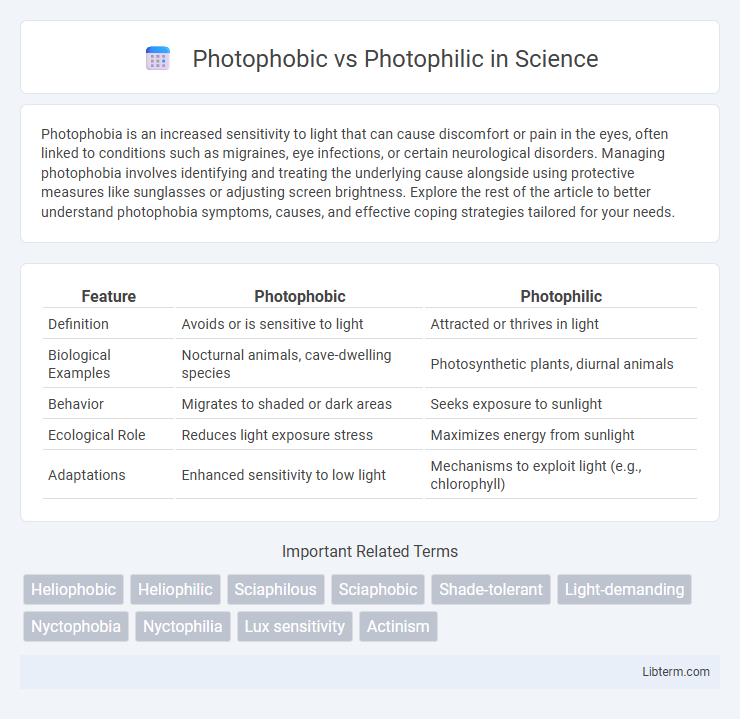Photophobia is an increased sensitivity to light that can cause discomfort or pain in the eyes, often linked to conditions such as migraines, eye infections, or certain neurological disorders. Managing photophobia involves identifying and treating the underlying cause alongside using protective measures like sunglasses or adjusting screen brightness. Explore the rest of the article to better understand photophobia symptoms, causes, and effective coping strategies tailored for your needs.
Table of Comparison
| Feature | Photophobic | Photophilic |
|---|---|---|
| Definition | Avoids or is sensitive to light | Attracted or thrives in light |
| Biological Examples | Nocturnal animals, cave-dwelling species | Photosynthetic plants, diurnal animals |
| Behavior | Migrates to shaded or dark areas | Seeks exposure to sunlight |
| Ecological Role | Reduces light exposure stress | Maximizes energy from sunlight |
| Adaptations | Enhanced sensitivity to low light | Mechanisms to exploit light (e.g., chlorophyll) |
Understanding Photophobic and Photophilic: Key Definitions
Photophobic organisms exhibit an aversion to light, often seeking darkness to avoid exposure, which is crucial for their survival and behavior in environments with intense illumination. Photophilic organisms, in contrast, are attracted to light, actively moving towards illuminated areas to optimize processes such as photosynthesis or predation. Understanding the key definitions of photophobic and photophilic traits highlights their ecological roles and adaptive significance in various species.
Biological Mechanisms Behind Light Sensitivity
Photophobic organisms exhibit aversion to light due to the activation of photoreceptor proteins that trigger neural pathways linked to stress or avoidance behaviors. In contrast, photophilic species rely on these photoreceptors to regulate circadian rhythms and promote activities such as feeding and reproduction. Differences in opsin expression and downstream signaling cascades underlie the varied biological mechanisms controlling light sensitivity across taxa.
Photophobic Organisms: Adaptations and Examples
Photophobic organisms exhibit a strong aversion to light, adapting to low-light or dark environments through specialized traits such as enhanced sensory organs for detecting minimal light and behaviors that avoid exposure to harmful radiation. Common examples include deep-sea fish like the anglerfish and cave-dwelling species such as the olm salamander, which thrive in habitats where light is scarce or absent. These adaptations enable photophobic species to conserve energy, avoid predators, and exploit ecological niches unavailable to photophilic organisms.
Photophilic Organisms: Adaptations and Examples
Photophilic organisms thrive in environments with abundant light, exhibiting adaptations such as specialized pigments that optimize photosynthesis and structural features that maximize light absorption. Examples include many plants like sunflowers and algae like *Cladophora*, which possess chlorophyll variants tuned to high-light conditions. These adaptations enable photophilic species to efficiently capture and utilize solar energy for growth and reproduction in sunlight-rich habitats.
Environmental Factors Influencing Light Preferences
Photophobic organisms exhibit avoidance behavior towards intense light to prevent damage from UV radiation and excessive heat, often thriving in shaded or low-light environments such as dense forests or underwater habitats. Photophilic species, in contrast, depend on abundant sunlight for photosynthesis or activities like foraging and reproduction, commonly found in open fields or sunlit aquatic zones. These light preferences are strongly influenced by environmental factors including UV intensity, ambient temperature, and habitat structure, which shape adaptive physiological and behavioral traits.
Human Photophobia and Photophilia: Causes and Symptoms
Human photophobia is characterized by an abnormal sensitivity to light, often caused by eye conditions such as migraines, conjunctivitis, or corneal abrasions, leading to symptoms like squinting, headaches, and eye pain. Photophilia, in contrast, describes a preference or tolerance for bright light, frequently seen in individuals with certain neurological conditions or in those who experience relief from depressive symptoms when exposed to sunlight. Understanding the underlying causes helps differentiate these responses, where photophobia signals protective mechanisms against light-induced discomfort, while photophilia involves a positive psychological or physiological response to illumination.
Photophobic vs Photophilic in Plants and Animals
Photophobic organisms, both plants and animals, exhibit avoidance or negative response to light, often thriving in shaded or dark environments to reduce exposure to intense illumination or UV damage. Photophilic species, conversely, actively seek and depend on light for processes like photosynthesis in plants or to regulate behaviors such as circadian rhythms in animals. Understanding the photophobic versus photophilic traits is crucial for studying habitat preferences, growth patterns, and adaptive strategies across diverse ecosystems.
Ecological Roles of Photophobic and Photophilic Species
Photophobic species, which avoid light, play critical ecological roles by inhabiting shaded or subterranean environments where they contribute to nutrient cycling and soil aeration. Photophilic species thrive in well-lit habitats, driving primary production through photosynthesis and supporting diverse food webs. Together, these contrasting light preferences maintain ecosystem balance by promoting niche differentiation and resource partitioning.
Photophobia, Photophilia, and Their Impact on Daily Life
Photophobia and photophilia describe contrasting light sensitivities, with photophobia causing discomfort or pain in bright light and photophilia indicating a preference or attraction to light. Individuals experiencing photophobia often face challenges in daily life such as difficulty in well-lit environments, increased eye strain, and the need for protective eyewear or dimmed surroundings to mitigate symptoms. In contrast, photophilic individuals may seek out brightly lit spaces, benefiting from enhanced mood and productivity linked to increased light exposure.
Managing Light Sensitivity: Tips and Treatments
Managing light sensitivity involves understanding photophobic and photophilic responses to light exposure. Photophobic individuals experience discomfort or pain in bright light, often requiring the use of tinted lenses, anti-glare screens, and controlled lighting environments to reduce symptoms. Photophilic individuals prefer or need increased light levels, benefiting from light therapy and environments with higher illumination to enhance mood and productivity.
Photophobic Infographic

 libterm.com
libterm.com